San Marco Art Story | Hours Address Tickets
Art Story Convent | Savonarola | Beato Angelico | B.Angelico Fra Bartolomeo | Frescoes Cloister
The Convent Museum of San Marco : Savonarola in Florence
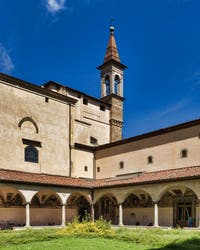
St. Mark Cloister The new convent of St. Mark was built for the Dominicans on the site of a Benedictine community between 1437 and 1444.
To achieve this, it took no less than the intervention of Pope Eugenio IV, who, in order to please Cosimo de" Medici the Elder, stripped the Benedictines of this property and offered it to the Dominicans of Fiesole.
Forty thousand florins were invested in the construction by Cosimo the Elder, who entrusted the project to his architect, Michelozzo.
The first prior of the new Dominican convent of St. Mark, Antonino Pierozzi (1389-1459), became Archbishop of Florence in 1446 and was canonised in 1523 as Saint Anthony.
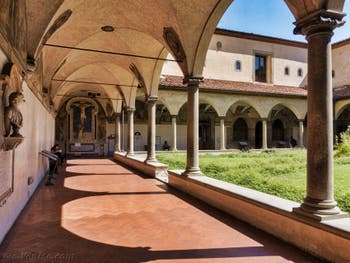
St. Mark cloister The complex is built around the church of St. Mark in two cloisters, the cloister of Sant"Antonino and, almost twice as large, the cloister of St. Dominic.
The latter cloister is not open to the public.
They are all decorated with frescoes painted mainly by Beato Angelico, also known as Fra Angelico, and Fra Bartolomeo.
These two monk-painters both lived in the convent.
Fra Angelico was canonised in 1983.
Two monks canonised solely for this convent !
Jerome Savonarola, Prior of the Convent of St. Mark

Jerome Savonarola And yet the most famous monk of the convent of St. Mark was a third, not canonised at all and even excommunicated: Savonarola!
Jerome Savonarola (1452-1498) began his career as a Dominican monk in Bologna before moving to Florence in 1489, where he was appointed prior just two years later.
He quickly became famous for his sermons against lust and the rulers of Florence.
While some may initially see him as a demagogue, it should not be forgotten that he was admired by the greatest intellectuals of the time, such as Pico della Mirandola and Angelo Politien.
Even Botticelli was influenced by him, an influence visible in his religious works.
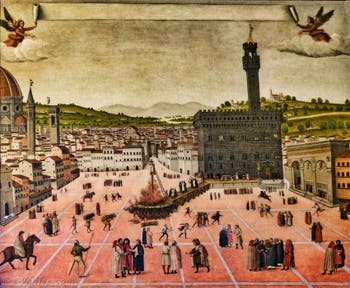
Execution of Savonarole Piazza Signoria Savonarola"s main crime was to attack the Medici and even the Pope directly, which was understandable when it came to lust, since the Pope at the time was none other than Alexander Borgia !
This fatal error led to his condemnation for sedition and heresy.
He was excommunicated, hanged and burned in the Piazza della Signoria, in front of the Palazzo Vecchio in Florence, the same place where Savonarola organised bonfires at which books and works of art were burned.
Every year in Florence, a procession known as the Infiorata (or Fiorita) takes place on 23 May, the anniversary of his death.
Rose petals are thrown at the spot where he was burnt, and the procession then proceeds to the Ponte Vecchio, from where rose petals are thrown into the Arno.
The Cloister of Sant"Antonin
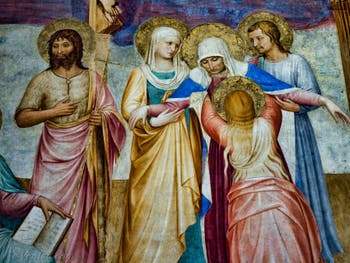
Crucifixion and Saints This charming cloister, dedicated to the convent"s first prior, Antonino Pierozzi, canonised as Saint Anthony, is covered in frescoes depicting the life of the saint.
The lunettes were mainly frescoed by Bernardino Poccetti, Matteo Rosselli and Michelangelo Cinganelli.
The corner frescoes are the work of Fra Angelico.
The 44 monks" cells on the first floor
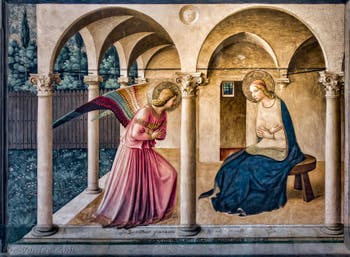
Beato Angelico - Annunciation Under a large wooden frame, 44 monastic cells can still be visited, each decorated with a fresco by Fra Angelico, inciting devotion.
A beautiful Annunciation by Fra Angelico can also be seen on this floor.
You can also see Savonarola"s cell, a reproduction of his chair and desk, as well as relics and clothes that once belonged to him, including his cloak.

Fra Beato Angelico Also on the first floor is the convent library, a beautiful room with three naves, where manuscripts with beautiful illuminations are on display.
It was in this library that Savonarola was arrested on the night of 8 April 1498, as commemorated by a marble plaque near the entrance.
Fra Bartolomeo also painted a portrait of Savonarola a few months before his death.
This portrait is in the museum on the ground floor, which contains a large number of works by Beato Angelico.
Art Story Convent | Savonarola | Beato Angelico | B.Angelico Fra Bartolomeo | Frescoes Cloister
San Marco Art Story | Hours Address Tickets
Back to Top of Page

